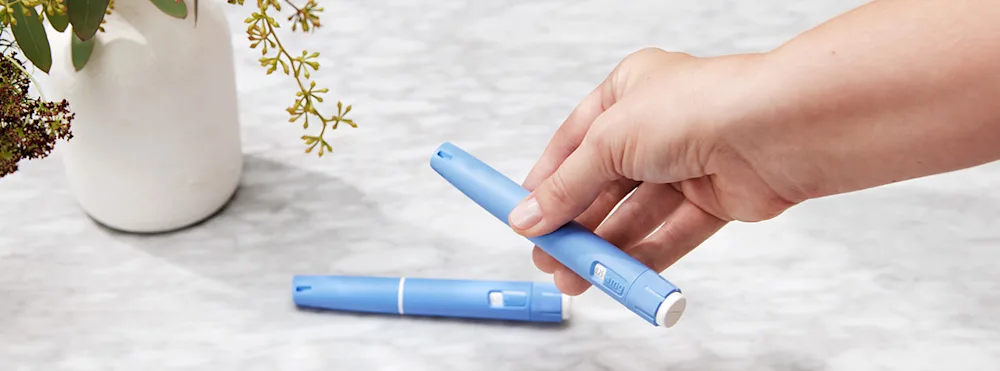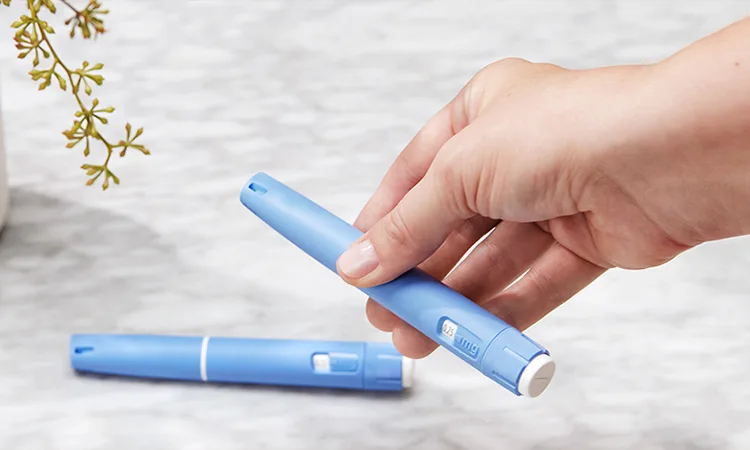Getting started with your GLP-1
You're taking an important step and making a GLP-1 or GIP/GLP-1 part of your journey to the healthiest you. That’s great!
Before you begin, here are some important things you should know to help you use your GLP-1 or GIP/GLP-1 correctly, learn what’s ahead, and kick-start your journey today!

What are GLP-1s?
GLP-1s are a type of medication called a glucagon-like peptide 1 (GLP-1) receptor agonists. These medications are often nicknamed “GLP-1s” for short, and they work by acting like a hormone that your body naturally makes to regulate blood sugar and appetite.
GIP/GLP-1 dual-action medications (short for “glucose-dependent insulinotropic polypeptide and glucagon-like peptide-1 receptor agonists”) work in similar ways as GLP-1 medications but target two hormones instead of one to regulate blood sugar and appetite.
You’ll receive one of several types of GLP-1 or GIP/GLP-1, depending on why it has been prescribed for you:
Wegovy
Wegovy is a brand of semaglutide that’s FDA-approved for long-term weight management in people with a body mass index (BMI) ≥30 kg/m2 and people with a BMI ≥27 kg/m2 with at least one weight-related medical condition (like high blood pressure or type 2 diabetes), when used in combination with a reduced-calorie diet and increased physical activity.
In the STEP 4 trial, participants who received lifestyle interventions and reached a weekly dose of 2.4 mg lost an average of 10.6% of their body weight after 20 weeks of continued use—and over 17% of their body weight after 68 weeks of continued use (Rubino, 2021).
Ozempic
Ozempic is a brand of semaglutide that’s FDA-approved for the management of certain symptoms and risks of type 2 diabetes, when used in combination with diet and exercise. For most people, using Ozempic may result in weight loss, and it can be prescribed at the provider’s discretion for weight loss.
In the STEP 2 trial, people with diabetes who received a lifestyle intervention and reached a weekly dose of 1 mg lost an average of 7.0% of their body weight in 68 weeks (Davies, 2021). A separate clinical trial showed that people with diabetes who combined a steady dose of 2.0 mg semaglutide per week with a healthy diet and exercise, plus another medication called metformin, lost approximately 6.4% of their body weight within 40 weeks (Frias, 2021).
Compounded semaglutide
Drug compounding is the process of combining, mixing, or altering ingredients to create a medication tailored to the needs of an individual patient. The compounded semaglutide prescribed by Ro-affiliated providers uses the same active pharmaceutical ingredient as brand-name forms of semaglutide (Wegovy and Ozempic).
Zepbound
Zepbound is a brand of tirzepatide that’s FDA-approved for long-term weight management in people with a body mass index (BMI) ≥30 kg/m2 and people with a BMI ≥27 kg/m2 with at least one weight-related medical condition (like high blood pressure or type 2 diabetes), when used in combination with a reduced-calorie diet and increased physical activity.
In a 72-week study of the use of Zepbound for weight loss, the average patient saw a 15% decrease in body weight if they took a maximum of 5 mg a week, a 19.5% decrease for those who took a maximum of 10 mg a week, and 20.9% for those taking the 15-mg weekly dose (Jastreboff, 2022).
Compounded tirzepatide
Drug compounding is the process of combining, mixing, or altering ingredients to create a medication tailored to the needs of an individual patient. The compounded tirzepatide prescribed by Ro-affiliated providers uses the same active pharmaceutical ingredient as brand-name forms of tirzepatide (Zepbound).
How your medication works
GLP-1s and GIP/GLP-1s are believed to help with weight management in two important ways (Hayes, 2011):
They slow down how quickly food leaves your stomach—making you feel full faster and satiated for longer
They talk directly to the part of your brain in charge of feeling full—helping you regulate how much you eat
These two effects, when combined with an appropriate diet and exercise, make GLP-1s and GIP/GLP-1s an excellent tool to support healthy weight management.
GLP-1s and GIP/GLP-1s can also be combined with a healthy diet and exercise to improve blood glucose control in people with type 2 diabetes mellitus. When blood glucose levels are high, GLP-1s cause an increase in a hormone called insulin and a decrease in another hormone called glucagon—a combined effect that lowers overall blood glucose levels (Novo Nordisk, 2022).
How and when to take it
The branded GLP-1s and GIP/GLP-1s prescribed by Ro-affiliated providers come in a prefilled injection pen. The compounded semaglutide and compounded tirzepatide prescribed by Ro-affiliated providers comes in vials that you will draw up into a syringe. With both approaches, you (or someone in your household) will administer the injection of semaglutide under the skin of your stomach, thigh, or arm.
Be sure to read the instructions that come with the pen before taking your first dose.
The instructions for different forms of GLP-1s and GIP/GLP-1s are very different. Find the steps for the medication you have below.
Wegovy instructions
Wegovy comes in single-use pens. You should receive a pack of four pens, each with the same dose.
Each prefilled pen has a tiny needle at the tip. The needle is covered, so it’s okay if you don’t see it. Each pen is meant to be used only once—after which it should be disposed of safely (like in a sharps container purchased from your local pharmacy or a heavy-duty plastic container with a screw-on lid).
You can watch a video showing how to use the injection pen here, or you can read the instructions below.
How to store your medication
The injection pens should be stored in the refrigerator at 36–46ºF, but they may be kept between 46–86ºF for up to 28 days.
When to take your dose
You’ll use one pen each week. Take your Wegovy on the same day each week (for example, every Monday), with or without food.
Steps
Wash your hands before handling your medication.
Preparing the medication
When you use a new pen, make sure the pen indicates the correct medication and dose that you were prescribed. Make sure that the expiration date has not passed.
Next, pull the cap of the pen straight off.
Inspect the medication—it should look clear and colorless, with no debris or particles in it. If it’s not, don’t use the medication. In that instance, contact your pharmacy and your Ro-affiliated provider for further guidance, since you may need a new pen.
If the medication looks clear, colorless, and particle-free, you can choose an injection site in either your stomach, thigh, or upper arm. You can use the same part of your body each week, but don’t inject it into the exact same spot in that body part each time.
Once you’ve selected a spot, it’s time to administer your medication!
Administering the injection
First, use an alcohol wipe to clean the area on the abdomen, thigh, or upper arm you’ve selected.
Press the pen firmly against your skin and hold the button down.
Injection should take about 10 seconds. You will hear two clicks during this process:
The first click means the injection has started. You should see the yellow bar on the pen start moving now. If the bar does not start moving, press the pen more firmly against the skin.
The second click means the injection is still going. Once you hear the second click, keep holding the button down until the yellow bar has stopped moving and you’ve reached 10 seconds. Don’t remove the pen until the yellow bar has stopped moving.
The yellow bar will stop right before the end of the window. Once the yellow bar has stopped moving, slowly remove the pen from your skin.
After you’ve administered the dose, dispose of the used pen in a sharps container (your local pharmacy may be able to provide one) or a heavy-duty plastic container with a screw-on lid. Because the semaglutide pen contains a needle, do not throw it into your regular trash.
Ozempic instructions
Ozempic comes in a “dial-a-dose” pen. Each pen contains multiple doses, and you’ll turn a dial to select the prescribed dose.
You’ll need to attach a new needle per the instructions below each time you administer a dose—after which the needle should be disposed of safely (like in a sharps container purchased from your local pharmacy, or a heavy-duty plastic container with a screw-on lid).
You can watch a video showing how to use the injection pen here, or you can read the instructions below.
How to store your medication
Before you use an injection pen for the first time, it should be stored in the refrigerator between 36–46ºF.
After a pen is first used, it may be kept outside the refrigerator between 59–86ºF for up to 56 days.
When to take your dose
You’ll use one pen each week. Take your Ozempic on the same day each week (for example, every Monday), with or without food.
Steps
Wash your hands before handling your medication.
Preparing the medication
First, make sure the pen indicates the correct medication that you were prescribed and that the expiration date has not passed.
Next, pull the cap of the pen straight off.
Inspect the medication—it should look clear and colorless, with no debris or particles in it. If it’s not, don’t use the medication. In that instance, contact your pharmacy and your Ro-affiliated provider for further guidance, since you may need a new pen.
If the medication looks clear, colorless, and particle-free, you can attach a new needle.
Take a new needle and tear off the paper tab. Do not take the cap off the needle just yet.
Holding the pen in one hand, take the capped needle between the thumb and forefinger of your other hand. Push the needle straight onto the pen. Turn clockwise until the needle is on tight.
Pull off the outer needle cap. Do not throw the outer cap away.
Pull off the inner needle cap. You can throw the inner cap away
Always use a new needle for each injection. Do not reuse a needle. Do not share needles with other people. Do not use a bent or damaged needle.
Check the Ozempic flow with each new pen
You should check the Ozempic flow each time you use a new pen. If you’ve previously used a pen, you should proceed to the “Select your dose” steps below.
To check the flow:
Turn the dose selector until the dose counter shows the flow check symbol, which looks like two dots and a dash: ••–.
Hold the pen with the needle pointing up toward the sky.
Press and hold in the dose button until the dose counter shows 0. The 0 must line up with the dose pointer.
A drop of Ozempic will appear at the needle tip.
If no drop appears, repeat Steps 1–3 up to six times. If this does not cause a drop to appear, replace the needle and repeat Steps 1–3 once more. If a drop of Ozempic still does not appear, contact your pharmacy or Ro-affiliated provider.
Select your dose
Turn the dose selector until the dose counter shows your dose.
If you have an Ozempic 2 mg pen (red label), you can only select doses of 0.25 mg or 0.5 mg. Follow the dosing instructions from your Ro-affiliated provider to select the correct dose.
If you have an Ozempic 4 mg pen (blue label), you can only select doses of 1 mg.
If you have an Ozempic 8 mg pen (yellow label), you can only select doses of 2 mg.
Administering the injection
Choose an injection site in either your stomach, thigh, or upper arm. You can use the same part of your body each week, but don’t inject it into the exact same spot in that body part each time.
First, use an alcohol wipe to clean the injection site you’ve chosen.
Insert the needle by pressing the pen firmly against your skin. Make sure you can see the dose counter.
Hold the button down until the dose counter turns to 0.
After the dose counter turns to 0, wait six seconds.
Remove the needle from your skin.
After administering the dose
Carefully remove the needle from the pen.
Dispose of the needle in a sharps container (your local pharmacy may be able to provide one) or a heavy-duty plastic container with a screw-on lid. Do not throw the needle into your regular trash.
Put the cap back onto your pen.
If your pen contains more medication, then store it in a safe location. If the pen contains no more medication, dispose of it in your sharps container or heavy-duty plastic container.
Compounded semaglutide instructions
Compounded semaglutide comes in a vial. You will draw the medication up from the vial into a syringe and administer the self-injection once a week.
You can watch a video showing how to use the injection pen here, or you can read the instructions below.
When your medication arrives:
The medication should arrive clear and colorless—and no part should be frozen or crystallized, even in winter. It must be stored in the prescription bottle it comes in and placed in your refrigerator as soon as you receive it. The packaging is designed to keep your medication within an appropriate temperature range. If you haven’t refrigerated your medication within 2 days of receiving it, or if it is not clear, colorless, or fully liquid, contact us at [email protected].
How to store your medication
Refrigerate your medication as soon as it arrives. Store the vial of medication in the prescription bottle it came in. Keep it in your refrigerator at 36º–46º F (2º–8º C). Discard any unused medication 28 days after first using the vial, or when the expiration date has passed, whichever comes first.
What to do if you have a previous prescription
In the event you happen to have a previous prescription for brand-name semaglutide or another GLP-1 in addition to your compounded semaglutide, do not take both medications simultaneously. Instead, discard your previously prescribed medication. Taking two or more of these medications together increases potentially severe side effects.
When to take your dose
Administer one dose each week, on the same day each week, at any time of day, with or without food.
What to have ready:
one (1) prescription bottle
one (1) vial of medication
one (1) sterile syringe with needle
two (2) alcohol wipes
one (1) vial seal sticker
one (1) hard plastic resealable container to dispose of used needle and syringe (such as an empty detergent bottle)
1. Before you start:
Wash your hands with soap and water.
Double-check the information on the prescription bottle, including the dose amount and expiration date. The medication should be clear and colorless.
2. Filling the Syringe
Gently shake the vial. If this is a new vial, remove the plastic cap. If not, remove the seal sticker you previously placed on the top. Now, clean the top of the vial with an alcohol wipe.
On the syringe, remove the caps from the plunger and the needle. It’s important to keep the needle sterile, so do not touch it.
While holding the syringe with the needle pointed up, pull the plunger down to the correct dose. Use the chart below:
Compounded Semaglutide Dosage | How much to draw |
0.25 mg (0.1 mL) | 10 units |
0.5 mg (0.2 mL) | 20 units |
1 mg (0.4 mL) | 40 units |
1.7 mg (0.68 mL) | 68 units |
2 mg (0.8 mL) | 80 units |
2.4 mg (0.96mL) | 96 units |
For example, if your dose is 0.25 mg, pull the plunger of the syringe down to the 10 units mark. For 68 units (1.7 mg) pull the plunger to the line right above the 70 units mark.
Insert the needle into the rubber part of the vial top and press down on the plunger to inject all of the air from the syringe into the vial. Injecting the air into the medication vial makes the next step easier!
While the needle is still in the vial, turn the vial upside down. Make sure the needle tip is surrounded by liquid. Pull back the plunger past your dose amount.
For example, if your dose is 10 units of medication, pull the plunger back beyond the 10 units mark.
Remove any air bubbles by tapping the syringe with your finger.
Push the plunger to the prescribed dose level on the syringe.
For example, if your prescribed dose is 10 units, push the plunger to the 10 units mark. For 68 units (1.7 mg) pull the plunger to the line right above the 70 units mark.
Turn the vial upright and then remove the needle.
Do not put the needle cap back on the needle.
You can put the syringe down by resting it on the needle cap so the tip of the needle doesn’t touch anything.
Apply a new vial seal sticker to the cap of the vial after each use. Press firmly to ensure adherence to the cap to prevent contamination.
3. Administering the injection:
Clean the area you want to inject with an alcohol wipe and allow the skin to dry. Your abdomen (at least two inches away from your belly button), thigh (front or outer thigh), or upper arm are all good injection sites, but choose a spot that is at least one finger’s width away from the last injection spot.
Change where you give the injection each time.
You can inject in the same area of your body each time—just make sure it’s not in the exact same spot every time. Moving injection spots is important to minimize the formation of permanent, fatty nodules that can arise and decrease the efficacy of your treatment. Ensure each injection location is at least one finger’s width away from the previous one.
Hold the syringe with the needle facing toward the ceiling. Push the plunger slightly until a drop of liquid forms at the end of the needle.
Pinch and hold the skin that you will inject.
Holding the syringe pointing directly at the pinched skin, quickly push the needle through the skin into the fat tissue, making sure to insert the entire length of the needle. Then slowly push the plunger to inject all of the medication.
Pull the needle out and clean the skin with an alcohol wipe or tissue. It’s normal to see a drop of blood at the injection spot. Press gently on the injection site for a few seconds to help stop the bleeding.
4. Discarding the syringe:
Discard the syringe in a sharps container or a heavy plastic container with a tight-fitting lid, like an empty detergent bottle.
Do not throw away the syringe directly in your household trash.
Saxenda instructions
Saxenda comes in a “dial-a-dose” pen. Each pen contains multiple doses, and you’ll turn a dial to select the prescribed dose.
You’ll need to attach a new needle per the instructions below each time you administer a dose—after which the needle should be disposed of safely (like in a sharps container purchased from your local pharmacy, or a heavy-duty plastic container with a screw-on lid).
You can watch a video showing how to use the injection pen here, or you can read the instructions below. How to store your medication Before you use an injection pen for the first time, it should be stored in the refrigerator between 36–46ºF.
After a pen is first used, it may be kept outside the refrigerator between 59–86ºF or in the refrigerator between 36–46ºF.
Do not freeze Saxenda, and do not use Saxenda if it has been frozen.
If your Saxenda pen has been used, it should be thrown away after 30 days even if there is still Saxenda left in it. Unused Saxenda may be used until the expiration date printed on the label, if kept in the refrigerator.
Keep Saxenda away from heat and out of the light.
When to take your dose You’ll take Saxenda once a day, every day.
You can take your Saxenda with or without food.
Steps Wash your hands before handling your medication.
Preparing the medication
First, make sure the pen indicates the correct medication that you were prescribed and that the expiration date has not passed.
Next, pull the cap of the pen straight off.
Inspect the medication—it should look clear and colorless, with no debris or particles in it. If it’s not, don’t use the medication. In that instance, contact your pharmacy and your Ro-affiliated provider for further guidance, since you may need a new pen.
If the medication looks clear, colorless, and particle-free, you can attach a new needle.
Take a new needle and tear off the paper tab. Do not take the cap off the needle just yet.
Holding the pen in one hand, take the capped needle between the thumb and forefinger of your other hand. Push the needle straight onto the pen. Turn clockwise until the needle is on tight.
Pull off the outer needle cap. Do not throw the outer cap away.
Pull off the inner needle cap. You can throw the inner cap away.
__Always use a new needle for each injection. Do not reuse a needle. Do not share needles with other people. Do not use a bent or damaged needle.__
Check the Saxenda flow with each new pen You should check the Saxenda flow each time you use a new pen. If you’ve previously used a pen, you should proceed to the “Select your dose” steps below.
To check the flow:
Turn the dose selector until the dose counter shows the flow check symbol, which looks like two dots and a dash: ••–.
Hold the pen with the needle pointing up toward the sky.
Press and hold in the dose button until the dose counter shows 0. The 0 must line up with the dose pointer.
A drop of Saxenda will appear at the needle tip.
If no drop appears, repeat Steps 1–3 up to six times. If this does not cause a drop to appear, replace the needle and repeat Steps 1–3 once more. If a drop of Saxenda still does not appear, contact your pharmacy or Ro-affiliated provider.
Select your dose
Turn the dose selector until the dose counter shows your dose (0.6 mg, 1.2 mg, 1.8 mg, 2.4 mg, or 3 mg).
Follow the dosing instructions from your Ro-affiliated provider to select the correct dose.
You will hear a “click” every time you turn the dose selector. Do not set the dose by counting the number of clicks you hear. Only the dose counter and dose pointer will show how many mg you select for each dose.
Administering the injection
Choose an injection site in either your stomach, thigh, or upper arm. You can use the same part of your body with each injection, but don’t inject it into the exact same spot in that body part each time. It is important to change the injection site with each dose to help prevent inflammation in that area.
First, use an alcohol wipe to clean the injection site you’ve chosen.
Insert the needle by pressing the pen firmly against your skin. Make sure you can see the dose counter.
Hold the button down until the dose counter turns to 0. The 0 must line up with the dose pointer.
After the dose counter turns to 0, wait six seconds.
Remove the needle from your skin.
After administering the dose
Carefully remove the needle from the pen.
Dispose of the needle in a sharps container (your local pharmacy may be able to provide one) or a heavy-duty plastic container with a screw-on lid. Do not throw the needle into your regular trash.
Put the cap back onto your pen.
If your pen contains more medication, then store it in a safe location. If the pen contains no more medication, dispose of it in your sharps container or heavy-duty plastic container.
Zepbound instructions
Zepbound-branded tirzepatide comes in single-use pens. You should receive a pack of four pens, each with the same dose.
Each prefilled pen has a tiny needle at the tip. The needle is covered, so it’s okay if you don’t see it. Each pen is meant to be used only once—after which it should be disposed of safely (like in a sharps container purchased from your local pharmacy, or a heavy-duty plastic container with a screw-on lid).
You can watch a video produced by the manufacturer to see how to inject Zepbound here.
How to store your medication
The injection pens should be stored in the refrigerator at 36–46º F, but they may be kept between 46–86º F for up to 21 days. If you store the pen at room temperature, do not return it to the refrigerator.
Store the pens in the original packaging to protect the pen from light. Do not freeze the pens. The pen contains glass parts, so If you drop the pen on a hard surface, do not use the pen for your injection.
When to take your dose
You’ll use one pen each week.
Take your Zepbound-branded tirzepatide on the same day each week (for example, every Monday), with or without food.
Steps
Wash your hands before handling your medication.
Preparing the medication
When you use a new pen, make sure the pen indicates the correct medication and dose that you were prescribed. Make sure that the expiration date has not passed. Make sure the pen is not damaged.
Inspect the medication—it should look clear and colorless, with no debris or particles in it. It should not be frozen. If any of these things are an issue, don’t use the medication. In that instance, contact your pharmacy and your Ro-affiliated practitioner for further guidance, since you may need a new pen.
If the medication looks clear, colorless, and particle-free, you can now prepare the pen. Make sure the pen is locked. Do not unlock the pen until you place the clear base on your skin and are ready to inject.
Pull the gray base cap straight off the pen and throw it away in your household trash. Do not put the gray base cap back on, and do not touch the needle.
Choosing your injection site
You can choose an injection site in either your stomach, thigh, or upper arm.
You can use the same part of your body each week, but don’t inject it into the exact same spot in that body part each time. Injecting into the same spot each time can lead to permanent fatty nodules under the skin that can decrease the effectiveness of the medication. A good guideline is to have your next injection site be at least 1 inch away from your last one.
Once you’ve selected a spot, it’s time to administer your medication!
Administering the injection
First, use an alcohol wipe to clean the area on the abdomen, thigh, or upper arm you’ve selected.
Place the clear base of the pen flat against your skin at the injection site.
Unlock the pen by turning the lock ring.
Press and hold the purple injection button for up to 10 seconds. You will hear two clicks during this process:
The first click means the injection has started.
The second click means the injection is done. You know the injection is complete when the gray plunger is visible.
Once the injection is complete, remove the pen from your skin.
Disposing of the injection pen
After you’ve administered the dose, dispose of the used pen in a sharps container (your local pharmacy may be able to provide one) or a heavy-duty plastic container with a screw-on lid (such as an empty detergent bottle). Because the pen contains a needle, do not throw it into your regular trash.
GLP-1 and GIP/GLP-1 dosing
GLP-1s usually start at a low dose and gradually increase to a dose that will remain steady for the remainder of your treatment.
Follow the instructions from your Ro-affiliated provider for dosing, as they may personalize your plan to your specific needs.
Wegovy typical dosing schedule
Weeks 1–4: 0.25 mg once a week
Weeks 5–8: 0.5 mg once a week
Weeks 9–12: 1.0 mg once a week
Weeks 13–16: 1.7 mg once a week
Week 17 and beyond: 2.4 mg once a week
(Novo Nordisk, 2021-b)
Ozempic typical dosing schedule
Weeks 1–4: 0.25 mg once a week
Weeks 5–8: 0.5 mg once a week
Weeks 9–12: 1.0 mg once a week
Week 13 and beyond: 2.0 mg once a week
(Novo Nordisk, 2022)
Compounded semaglutide typical dosing schedule
Weeks 1–4: 0.25 mg once a week
Weeks 5–8: 0.5 mg once a week
Weeks 9–12: 1 mg once a week
Weeks 13–16: 1.7 mg once a week
Weeks 17+: 2.4mg once a week
Zepbound typical dosing schedule
Weeks 1–4: 2.5 mg once a week
Weeks 5–8: 5 mg once a week
Weeks 9–12: 7.5 mg once a week
Weeks 13–16: 10 mg once a week
Weeks 17–20: 12.5 mg once a week
Weeks 21 and beyond: 15 mg once a week
Saxenda typical dosing schedule
Week 1: 0.6 mg once a day
Week 2: 1.2 mg once a day
Week 3: 1.8 mg once a day
Week 4: 2.4 mg once a day
Weeks 5 and beyond: 3 mg once a day
(Novo Nordisk, 2021-a)
5 tips to get the best results from your medication

Stick to a routine
If you are prescribed semaglutide (Wegovy, Ozempic, or compounded) or tirzepatide (Zepbound or compounded tirzepatide), you can take it on any day of the week, at any time of day, either with or without food. Once you pick a day, stick with that same day each week to make taking your medication a habit. If you are prescribed liraglutide (Saxenda or Victoza), you must take it every day, at any time of day, either with or without food. Once you pick a time of day, stick with that time every day to make taking your medication a habit.

Don’t skip a dose
When life gets busy, it’s very easy to forget to take a medication. But skipping a dose may impact how much benefit you’ll see from your GLP-1 or GIP/GLP-1. . If you’re afraid you’ll forget to use your medication on schedule, there are plenty of tricks to help you remember. You might try setting a phone reminder, marking each dose on your calendar, or taking it right before an activity you do on a regular basis.

Eat a healthy, reduced-calorie diet
All successful weight loss plans require that you decrease how many calories you eat and drink each day—and the same is true if weight management is one of the aims of your treatment. When GLP-1s and GIP/GLP-1s have been studied, participants were told to follow a reduced-calorie diet. That, plus the medication, helped participants lose a significant amount of their bodyweight over time.
By helping you feel full faster and longer, your medication can make reducing calories easier, but it’s still possible to consume too many even while taking a GLP-1 or GIP/GLP-1.
First, focus on getting used to making your medication part of your routine. Once you do, we’ll be sending you tips on how to shop for healthy foods and make smart changes to the way you eat—all to help you get the most out of your weight loss journey.

Make exercise part of your routine
Like a healthy diet, exercise is an essential part of improving your health. In most studies evaluating GLP-1s and GIP/GLP-1s, participants were instructed to perform moderate exercise (like a brisk walk) for 30 minutes a day, five days a week. But again, for now, focus on getting the hang of taking your medication. Soon, we will send you tips on how to get your body moving so you can see the best results.

Keep an eye on your email
Your experience doesn’t end when your medication is delivered. We want to see you find the most success and satisfaction with your weight loss journey. That’s why we’ll be sending you tips and tricks from our medical content team every week. Each article will be packed with useful insights and support for each step of your journey, so be on the lookout!
Frequently asked questions
When will I see my weight change?
We know—it’s exciting to see numbers on the scale drop right away. Everyone responds to GLP-1s and GIP/GLP-1s differently, so it’s difficult to say exactly when you’ll see results if you’re taking it for weight management.
In clinical trials evaluating GLP-1s, the average person saw noticeable weight loss within the first eight weeks. Depending on the medication used, the average person then lost 4–12% of their bodyweight after 20 weeks of medication plus lifestyle changes (Davies, 2015; Davies, 2021; Frías, 2021; Pi-Sunyer, 2015; Rubino, 2021; Wilding, 2021; Jastreboff, 2022).
Long-term use during clinical trials typically resulted in more weight lost. Those who were taking semaglutide and who reached a steady dose of 2.4 mg per week lost an average of over 17% of their body weight within 68 weeks (Rubino, 2021). People who took tirzepatide and reached a steady dose of 15 mg per week lost an average of 20.9% of their body weight within 72 weeks (Jastreboff, 2022). And people who were taking liraglutide and reached a steady dose of 3.0 mg per day lost an average of 7.9% of their bodyweight by 56 weeks (Pi-Sunyer, 2015).
In trials, people with diabetes tended to have a slower rate of weight loss and a lower total percentage of bodyweight lost.
But just like everyone’s body is different, no two weight loss journeys are the same. If you have concerns about how effective your GLP-1 or GIP/GLP-1 is for you, reach out to your Ro-affiliated provider for help.
Do I need to eat—or avoid eating—around my dose?
You can use your GLP-1 or GIP/GLP-1 either with or without food.
Can I drink alcohol when using my GLP-1 or GIP/GLP-1?
So far, there haven’t been any studies to answer this question.
However, drinking less alcohol is a great way to help you reduce the number of calories you consume each day and could be a helpful part of your weight management plan. With 125–150 calories in one glass of wine or one can of beer, drinking less alcohol can easily help you reach the goal of reducing your daily calories.
What if I forget to take a dose?
Life can get busy, and it can sometimes be easy to forget to administer your medication from time to time.
Don’t worry! There are some simple rules to follow if you miss a dose:
If you are taking Wegovy, Ozempic, or compounded semaglutide:
If you forget to take your dose, but it’s more than 48 hours before the next dose is scheduled, you should take the missed dose right away. Then, take the next dose on its regularly scheduled day.
Example: You usually take your dose on Saturdays, but one time you forget and don’t realize that you’ve forgotten until Wednesday. The next Saturday’s dose is more than 48 hours away, so you should take that missed dose on the day you’ve remembered to take it (Wednesday), then take the next dose on schedule (Saturday).
If the next dose is less than two days away, don’t take the missed dose. Instead, wait for the next scheduled dose and take that one on time. If you’re not sure what to do, contact your Ro-affiliated provider for advice.
Example: You usually take your dose on Saturdays, but one time you forget and don’t realize you’ve forgotten until Friday. The next Saturday’s dose is less than 48 hours away, so you should not take the missed dose. Instead, wait for the next scheduled dose (Saturday).
If you’ve missed more than two weeks of doses, don’t take your next dose. Contact your Ro-affiliated provider for the next steps.
If you are taking Zepbound or compounded tirzepatide:
If you forget to take your dose, but it’s been less than 4 days (96 hours) since you were supposed to take it, you should take the missed dose right away. Then, take the next dose on its regularly scheduled day.
Example: You usually take your dose on Saturdays, but one time you forget and don’t realize that you’ve forgotten until Tuesday. Tuesday is less than 4 days after Saturday, so you should take that missed dose on the day you’ve remembered to take it (Tuesday), then take the next dose on schedule (the upcoming Saturday).
If it’s been more than 4 days (more than 96 hours) since you were supposed to take the dose, don’t take the missed dose. Instead, wait for the next scheduled dose and take that one on time. If you’re not sure what to do, contact your Ro-affiliated provider for advice.
Example: You usually take your dose on Saturdays, but you don’t remember until Thursday. Thursday is more than 4 days after Saturday, so don’t take the missed dose. Instead, only take the next scheduled dose (the upcoming Saturday).
If you are taking Saxenda:
If a dose is missed, the once-daily regimen should be resumed as prescribed with the next scheduled dose. An extra dose or increase in dose should not be taken to make up for the missed dose.
Example: If you forget to take your Monday dose, take your next dose on Tuesday as prescribed. Do not take an extra dose or higher dose on Tuesday to make up for missing Monday.
If more than 3 days have elapsed since the last dose, go back to taking 0.6 mg daily. Contact your Ro-affiliated provider to discuss how to start increasing your dose again.
Example: If you forget to take your dose on Monday, Tuesday, Wednesday, and Thursday, take 0.6 mg on Friday—no matter what dose you were taking before that. Contact your Ro-affiliated provider to discuss how to begin increasing your dose again.
What if I’m not comfortable injecting myself?
Getting an injection may be a new experience for you, so you might be concerned about it. Branded GLP-1s and GIP/GLP-1s come in a pen that uses a tiny needle to minimize discomfort during injections, and the syringe used with compounded semaglutide also uses a small needle for the same reason.
If you’re uncomfortable with giving yourself an injection, you could ask another responsible adult to administer it for you. You can also reach out to your Ro-affiliated Coaching Team—they can give you tips on familiarizing yourself with the process and getting more comfortable using the pen.
Side effects of GLP-1s and GIP/GLP-1s
Tirzepatide (Zepbound and compounded tirzepatide) and oral contraception (birth control pills)
What you should know about how tirzepatide affects birth control
What to do if you’re taking other medications
Who shouldn’t take a GLP-1 or GIP/GLP-1
Sources
Davies, M. J., Bergenstal, R., Bode, B., Kushner, R. F., Lewin, A., Skjøth, T. V., Andreasen, A. H., Jensen, C. B., DeFronzo, R. A., & NN8022-1922 Study Group (2015). Efficacy of Liraglutide for Weight Loss Among Patients With Type 2 Diabetes: The SCALE Diabetes Randomized Clinical Trial. JAMA, 314(7), 687–699. doi: 10.1001/jama.2015.9676. Retrieved from https://jamanetwork.com/journals/jama/fullarticle/24289560
Davies, M., Færch, L., Jeppesen, O. K., Pakseresht, A., Pedersen, S. D., Perreault, L., Rosenstock, J., Shimomura, I., Viljoen, A., Wadden, T. A., Lingvay, I., & STEP 2 Study Group (2021). Semaglutide 2·4 mg once a week in adults with overweight or obesity, and type 2 diabetes (STEP 2): a randomised, double-blind, double-dummy, placebo-controlled, phase 3 trial. Lancet (London, England), 397(10278), 971–984. doi: 10.1016/S0140-6736(21)00213-0. Retrieved from https://pubmed.ncbi.nlm.nih.gov/33667417/
Frías, J. P., Auerbach, P., Bajaj, H. S., Fukushima, Y., Lingvay, I., Macura, S., Søndergaard, A. L., Tankova, T. I., Tentolouris, N., & Buse, J. B. (2021). Efficacy and safety of once-weekly semaglutide 2.0 mg versus 1.0 mg in patients with type 2 diabetes (SUSTAIN FORTE): a double-blind, randomised, phase 3B trial. Lancet Diabetes & Endocrinology, 9(9), 563–574. Doi: 10.1016/S2213-8587(21)00174-1. Retrieved from https://pubmed.ncbi.nlm.nih.gov/34293304/
Hayes, M. R., Leichner, T. M., Zhao, S., Lee, G. S., Chowansky, A., Zimmer, D., et al. (2011). Intracellular signals mediating the food intake-suppressive effects of hindbrain glucagon-like peptide-1 receptor activation. Cell Metabolism, 13(3), 320–330. doi:10.1016/j.cmet.2011.02.001. Retrieved from https://www.ncbi.nlm.nih.gov/pmc/articles/PMC3108145/
Jastreboff, A. M., Aronne, L. J., Ahmad, N. N., Wharton, S., Connery, L., Alves, B., Kiyosue, A., Zhang, S., Liu, B., Bunck, M. C., Stefanski, A., & SURMOUNT-1 Investigators (2022). Tirzepatide Once Weekly for the Treatment of Obesity. The New England journal of medicine, 387(3), 205–216. Retrieved from https://www.nejm.org/doi/full/10.1056/NEJMoa2206038
Lilly. 2022. Zepbound PI. Retrieved November 27, 2023 from https://pi.lilly.com/us/zepbound-uspi.pdf
Novo Nordisk. 2021-a. Saxenda PI. Retrieved May 26, 2022 from https://www.novo-pi.com/saxenda.pdf
Novo Nordisk. 2021-b. Wegovy PI. Retrieved April 05, 2022 from https://www.novo-pi.com/wegovy.pdf
Novo Nordisk. 2021-c. Victoza PI. Retrieved May 27, 2022 from https://www.novo-pi.com/victoza.pdf
Novo Nordisk. 2022. Ozempic PI. Retrieved April 05, 2022 from https://www.novo-pi.com/ozempic.pdf
Pi-Sunyer, D., et al. (2015). A randomized, controlled trial of 3.0 mg liraglutide in weight management. The New England Journal of Medicine (NEJM), 373(1), 11–22. doi: 10.1056/NEJMoa1411892. Retrieved from https://www.nejm.org/doi/full/10.1056/nejmoa1411892
Rubino, D., et al. (2021). Effect of continued weekly subcutaneous semaglutide vs placebo on weight loss maintenance in adults with overweight or obesity. JAMA, 325(14), 1414. doi: 10.1001/jama.2021.3224. Retrieved from https://jamanetwork.com/journals/jama/fullarticle/2777886
Wilding, J., Batterham, R. L., Calanna, S., Davies, M., Van Gaal, L. F., Lingvay, I., et al. (2021). Once-Weekly Semaglutide in Adults with Overweight or Obesity. The New England Journal of Medicine (NEJM), 384(11), 989. doi:10.1056/NEJMoa2032183. Retrieved from https://www.nejm.org/doi/10.1056/NEJMoa2032183?url_ver=Z39.88-2003&rfr_id=ori:rid:crossref.org&rfr_dat=cr_pub%20%200pubmed
More from part 1
Strong foundations
These lessons about your medication, discovering your unique Body Story, finding your personal inspiration, and our foundational approach to nutrition are the building blocks for your Ro Body journey.



